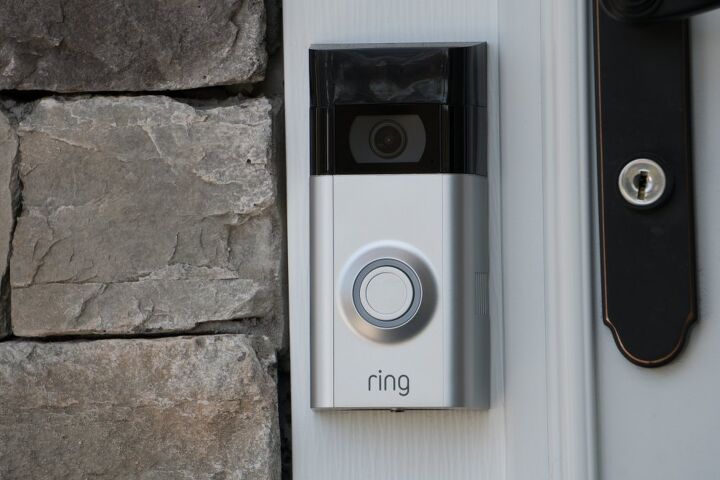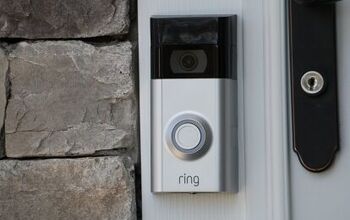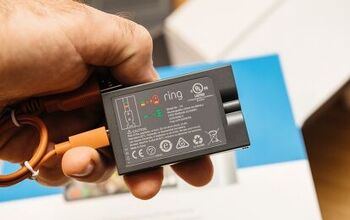Ring Doorbell Hardwired But Not Charging? (Possible Causes & Fixes)

The Ring Doorbell is designed to be hardwired into the existing doorbell transformer. This does two things. It allows the Ring doorbell to activate the home’s interior chime, and it trickle-charges the Ring’s lithium-ion battery pack.
A Ring doorbell that is hardwired to a doorbell transformer that is too small may not receive enough power for both operation and charging. Ring needs 16V to 24V to operate. Freezing temperatures will stop the charging of lithium-ion batteries. A Ring that is activated frequently will drain the batteries faster than they can be recharged by the transformer.
Later models have a removable battery pack that can be plug-in charged for five to 10 hours. Meanwhile, the unit is inoperable unless they have a replacement battery pack.
Do You Need a Smart Home System Installation or Service?
Get free, zero-commitment quotes from pro contractors near you.

How To Charge a Ring Doorbell Without Batteries
The very first versions of the Ring Video Doorbells do not have removable battery packs. They are sometimes hardwired to the home’s doorbell transformer for charging. However, if the doorbell will not take a trickle charge, then it has to be unmounted and charged indoors.
Once plugged into a wall charger the unit will charge in five to 10 hours. This is not an acceptable option for those who use the unit for home security. For others, this can be done overnight when packages and visitors are not expected.
Ring Battery Pack Will Not Charge
The Ring battery pack is made with lithium-ion batteries. These are small, efficient batteries that have some big drawbacks over time. The main drawback is the limited lifespan of lithium-ion batteries.
- When the battery pack is near end-of-life it will not take as much charge as it does when it is new.
- A typical lithium-ion battery can take around 500 charge cycles. A charge cycle is a full discharge/charge cycle. When the batteries are not fully discharged and recharged the lifespan is further limited.
- Lithium-ion batteries degrade over time. They lose efficiency and the amount of electricity that they can store.
- These batteries self-discharge so that they lose battery capacity even when they sit idle.
This means that the older a Ring doorbell gets, it will need more frequent recharging and the charging time will be longer.
If the battery pack is especially unreliable, the weather is not below freezing, and the doorbell transformer is newer or confirmed to be delivering enough voltage for charging, then the battery pack probably needs to be replaced.
Ring Doorbell Will Not Recharge In Extreme Cold
When the doorbell is installed in areas where the temperatures regularly drop below freezing, the performance of the unit degrades. Lithium-ion batteries will not perform well at temperatures below freezing.
- The Ring doorbell can be used to -5 degrees. However, at only 36-degrees F, battery charging capacity is affected.
- Lithium-ion batteries have trouble charging at 32-degrees F and may stop working altogether at -5-degrees F.
- In the case of cold weather, the doorbell’s battery will not take a charge until it warms up. Even when it is receiving a trickle charge, it may not retain the charge because the unit is too cold.
- When frequent use is combined with cold weather, the Ring doorbell will have trouble with charging and maintaining battery life.
Ring doorbells that are mounted in cold climates need to have backup battery packs that are swapped out more often. This is because the pack will not perform up to the official Ring standards until the weather warms up to a balmy 36-degrees F or higher.
Doorbell Transformer Will Not Charge Ring
Older homes often have low-powered doorbell transformers. When Ring doorbell owners hardwire the doorbell to the transformer, it is not enough voltage to charge the doorbell.
What Is a Doorbell Transformer?
The doorbell transformer is a small box that is usually wired into a junction box somewhere near the home’s breaker box or the doorbell. It has two screw terminals on the front that accept the wires that power the doorbell.
The transformer takes the 120V AC that is coming into the home and transforms or steps it down to the voltage that is needed to run the particular doorbell.
Doorbells, including Ring doorbells, have different voltage requirements.
- The first versions can run on a low-powered 8V transformer.
- Newer models need between 16V and 20V AC to run.
- The additional voltage is needed to trickle-charge the batteries and power the interior door chime.
An underpowered transformer will cause the doorbell to make strange noises, it may not charge the Ring device batteries, and it could be a fire hazard.
How To Spot an Underpowered Transformer
Symptoms of an underpowered transformer can come and go if the Ring unit is used intermittently and then allowed to recharge.
- Poor battery performance or a battery pack that will not charge may be a sign of an overtaxed doorbell transformer. This type of symptom is more common for Ring devices that are set to high sensitivity so that they are working very frequently.
- A doorbell transformer that is bulging, burning hot to the touch or shows signs of heat deterioration such as browning or blackening on the unit is a fire hazard. Turn off the doorbell power at the breaker box and leave it off until the transformer has been replaced.
- Buzzing or humming that comes from the transformer or the interior door chime.
Signs of transformer failure sometimes occur after a Ring device has been installed for a while. This happens because the old transformer may have had a bit of life left that has been worn out by the constant demands of powering a Ring doorbell.
The old transformer was working fine when it was lying dormant unless a doorbell button was pushed but is now being required to provide charging as well as working the interior chime.
What Voltage Do I Need for the Ring Doorbell?
The voltage requirements for Ring devices are included with the paperwork, and can also be located on the Ring website in the model information section.
- New doorbell transformers are easily purchased at a local hardware store and are located in the same area as the doorbells.
- Doorbell transformers of all sizes are also available on Amazon.
- The new transformer must be capable of providing the voltage needed to run the Ring doorbell.
- Transformers typically need to be between 16V and 24V AC to power Ring doorbells.
If the Ring owner chooses to diagnose or replace the transformer as a DIY project, it is important to remember to turn off the breaker to the doorbell at the breaker box.
Never work on electrical components while they are live. While the output of the transformer may be only 8V or 16V, the power coming in the back is still 120V.
Ring Doorbell Activates Too Frequently
If the Ring doorbell is set to activate at every possible motion, this can use up battery power faster than it is replaced by the trickle-charging system.
- The Ring Video Doorbell battery pack is designed to last for 1,000 events when it is brand new. The number of events that it can power will steadily decline over the life of the battery pack.
- An event includes motion sensor activation, manual doorbell rings, and video recordings.
- Some Ring owners will get months of usage on a single charge.
- Ring owners with a busy front porch may have dead batteries in a week or two.
When the unit is being used in a busy area that frequently triggers the Ring doorbell, the best way for owners to fix low battery issues is to adjust the motion zones and the motion frequency settings.
How To Adjust Motion Zones and Frequency
The first step is to adjust the motion zones to include a smaller target area. This will help to eliminate unnecessary motion sensor activations.
- Open the Ring app and select “motion settings.” Both of the adjustments that need to be made are in this section.
- Select “motion zones.” The app will help owners set up motion zones. Zones should be set to avoid picking up activity in high-traffic areas such as a sidewalk or a busy road.
- Minimizing the motion zones will help to keep the motion sensors off instead of picking up all passing traffic, animals, and foot traffic.
The more the unit is off the better the batteries will charge, so aim to keep the motion zones as small as can comfortably be used.
Adjust Ring Doorbell Motion Frequency
This adjustment takes place in the same area of the app and decreases the sensitivity of the motion sensors.
- Select “advanced settings” and then choose from “frequently,” “regularly,” or “periodically.” These settings pertain to the frequency of the motion sensor activation.
- When the setting is on “frequently,” the motion sensors will activate at every possible hint of motion. This drains the batteries very fast, and the trickle-charge will not keep up if the Ring is located in an area with a lot of activity.
- When the setting is on “regularly,” the sensors will take a short break in-between activations. This is necessary to avoid receiving multiple notifications for the same event such as a delivery person walking up, dropping a package, and then walking back down.
- “Periodically” sets the sensors to take a longer break before they reactivate. This is ideal for areas where there are not a lot of front-door interruptions, but there is a lot of outside activity such as animals running or kids playing. The doorbell will take a break after the first alert and will not scan for motion again for a while.
Setting the motion sensor frequency to periodically scan will also eliminate false alarms during bad weather.
Do You Need a Smart Home System Installation or Service?
Get free, zero-commitment quotes from pro contractors near you.

Related Questions
Why is my Ring Doorbell Hardwired but not ringing?
The Ring doorbell uses the wires to charge its batteries and ring the door chime. If it is paired with an incompatible doorbell kit, it may be able to charge but not activate the door chime. Check the Ring website for a list of compatible doorbells.
What is the difference between Ring Doorbell Hardwired and Battery?
Hardwired models use the house doorbell transformer to trickle-charge the lithium-ion batteries so that owners do not need to disassemble and charge the unit. Battery-only units require charging. Both units use the battery pack to power motion sensors, cameras, and chime.
What is the Ring Doorbell hardwired voltage?
Newer models of Ring doorbells require between 16V and 24V AC coming from the doorbell transformer to power them with full functionality. Specific requirements are included with each Ring doorbell or can be found on the Ring website by model.

Hannah DeMoss has been a writer for nearly a decade. Her passion for writing began years ago has continued to grow. Her expertise at home involves furniture restoration and other small DIY tasks. When not writing, Hannah enjoys the outdoors with her husband and pups, as well as traveling.
More by Hannah DeMoss















![Cost To Drill A Well [Pricing Per Foot & Cost By State]](https://cdn-fastly.upgradedhome.com/media/2023/07/31/9074980/cost-to-drill-a-well-pricing-per-foot-cost-by-state.jpg?size=350x220)
![12 Washing Machine Brands to Avoid [with Recall Data]](https://cdn-fastly.upgradedhome.com/media/2023/07/31/9075781/12-washing-machine-brands-to-avoid-with-recall-data.jpg?size=350x220)










